
The Breed History
This particular mastiff breed is first recorded in Britain around
1860. Like the Old English Mastiff (Syn. Mastiff), it is one of many
mastiff-type dogs that originated from ancient Asian stock. The
cross of 60% English Mastiff with 40% English Bulldog produced
this breed. In 1924, the English Kennel Club first recognized
Bullmastiffs as a breed, and in 1933-34, the AKC also recognized
this breed.
Breeding for Function
To protect estates from poachers, the bulldog-mastiff type was
ideal. They were silent workers, following a human trail by odor, and
when pinned down, did not maul their intruders but just held them.
Later, they became very popular as guarding and watchdogs.
Physical Characteristics
Height at Withers: female 24-26" (61-66 cm), male 25-27"
(63.5-68.5cm).
Weight: females 100-120 lb (45.5-54.5 kg), males 110-130 lb
(50-59 kg).
Coat: The short, very dense haircoat is acceptable in fawn, red and
brindle. Only a very small white marking on the chest is acceptable.
Longevity: 9-10 years
Points of Conformation: The Bullmastiff is smaller and more
compact, with more of a bulldog type head than the English
Mastiff. This alert powerful dog is about as long as tall. The
skull is large, with a well-wrinkled forehead when alert. Eyes are
medium-sized and dark colored, and ears are triangular and carried
close to the head; set high. They possess a moderate stop, and the
muzzle is deep and broad with dark coloration. Nose is black and
large, and the flews moderately pendulous. The neck is moderate
in length and arch, with well-developed musculature. The topline
is level, and the thorax is wide and deep, with well-sprung ribs. The
tail is high set and tapers to end at the tarsus; it is straight/slightly
curved. Limbs are heavily boned and straight, feet are medium sized
with well-arched toes, black nails and thick pads. The Bullmastiff
moves with a ground-covering smooth stride.
Recognized Behavior Issues and Traits
Reported breed attributes include: Gentle, self assured, courageous,
sensitive to temperature extremes, intelligent, and some are a bit
overprotective and may resist obedience training. Very aloof with
strangers so early socialization and obedience training is important.
Low to moderate exercise needs, good for town or country, low
grooming needs, moderate shedders, and have a high drooling and
snoring tendency. Good dog for experienced dog handlers.
Normal Physiologic Variations
35% of Bullmastiff litters are delivered by C-section according to a
UK study.1
Drug Sensitivities
None reported
Inherited Diseases
Hip Dysplasia: Polygenically inherited trait causing degenerative
joint disease and hip arthritis. OFA reports 24.5% affected.
Elbow Dysplasia: Polygenically inherited trait causing elbow
arthritis. OFA reports 13.8% affected. Reported 38.9x odds ratio for
the fragmented coronoid process form of elbow dysplasia versus
other breeds.
Progressive Retinal Atrophy (PRA): An autosomal dominant form
of PRA occurs in the breed, with an onset of 6 months to 4 years of
age. A genetic test is available.
Patella Luxation: Polygenically inherited laxity of patellar
ligaments, causing luxation, lameness, and later degenerative
joint disease. Treat surgically if causing clinical signs. Too few
Bullmastiffs have been screened by OFA to determine an accurate
frequency.
Multifocal Retinopathy/Retinal Dysplasia: Autosomal recessive
retinal pigment epithelial dysplasia causing localized multifocal
retinal detachments. Age of onset from 11 to 13 weeks of age.
Reported in 5.26% of Bullmastiffs CERF examined by veterinary
ophthalmologists between 2000-2005. A genetic test is available.
Glomerulonephropathy: Rare disorder, where affected dogs
present between the ages of 2.5 and 11 years with clinical and
laboratory signs of chronic renal failure. Histopathology shows
chronic glomerulonephropathy with sclerosis. Pedigree analysis
supports an autosomal recessive mode of inheritance.
Cerebellar Ataxia with Hydrocephalus: Rare disorder, where
affected puppies have ataxia, hypermetria, conscious proprioceptive
deficits, behavioral abnormalities, and a visual deficit. Brain MRI
shows symmetric hydrocephalus and focal areas of increased signal
intensity within the central nuclei of the cerebellum. Histopathological
findings are vacuolation, gliosis and axonal degeneration within the deep cerebellar nuclei. This disorder is most likely
inherited in an autosomal recessive manner.
Disease Predispositions
Entropion: Rolling in of eyelids, often causing corneal irritation
or ulceration. Entropion is reported in 7.12% of Bullmastiffs CERF
examined by veterinary ophthalmologists between 2000-2005.
Hypothyroidism: Inherited autoimmune thyroiditis. 5.8% positive
for thyroid auto-antibodies based on testing at Michigan State
University. (Ave. for all breeds is 7.5%).
Distichiasis: Abnormally placed eyelashes that irritate the cornea
and conjunctiva. Can cause secondary corneal ulceration. Identified
in 4.02% of Bullmastiffs CERF examined by veterinary ophthalmologists
between 2000-2005.
Persistent Pupillary Membranes: Strands of fetal remnant
connecting; iris to iris, cornea, lens, or involving sheets of tissue. The
later three forms can impair vision, and dogs affected with these
forms should not be bred. Identified in 3.10% of Bullmastiffs CERF
examined by veterinary ophthalmologists between 2000-2005, with
1.55% being iris to cornea.
Ectropion: A rolling out of the eyelids, that can cause tear pooling,
conjunctivitis, and frequent infection. Can be secondary to
macroblepharon; an abnormally large eyelid opening. Ectropion is
reported in 3.10%, and macroblepharon in 2.79% of Bullmastiffs
CERF examined by veterinary ophthalmologists between
2000-2005.
Osteochondritis Desicans (OCD): Polygenically inherited joint
cartilage defect. Causes joint pain and lameness in young growing
dogs. Mild cases can resolve with rest, while more severe cases
require surgery. Reported 85.9x odds ratio for hock OCD, and 6.7x
odds ratio for shoulder OCD versus other breeds.
Cranial Cruciate Ligament Rupture (ACL): Traumatic tearing of
the anterior cruciate ligament. Dorn reports a 2.80x odds ratio in
Bullmastiffs versus other breeds. Treatment is surgery.
Cataracts: Capsular cataracts predominate, though anterior,
posterior, and nuclear cataracts also occur in the breed. Identified in
2.79% of Bullmastiffs CERF examined by veterinary ophthalmologists
between 2000-2005. CERF does not recommend breeding any
Bullmastiff with a cataract.
Gastric Dilatation-Volvulus (bloat, GDV): Polygenically inherited,
life-threatening twisting of the stomach within the abdomen.
Requires immediate treatment. Reported at an increased frequency
in the breed.
Dilated Cardiomyopathy (DCM): Dilated cardiomyopathy
causing heart failure is identified in the breed. Unknown mode of
inheritance.
Cystine Urinary Calculi: Bullmastiffs are a breed with increased
risk of developing cystine calculi, due to an abnormality of cystine
metabolism.
Lymphoma/Lymphosarcoma: Malignant cancer of lymphoid
tissue. An increased prevalence is seen in the breed. In one study, a
large family of Bullmastiffs was identified, where 15% of the dogs
developed lymphosarcoma over a three year period.
Optic Nerve Hypoplasia: A congenital defect of the optic nerve
which causes blindness and abnormal pupil response in the affected
eye. CERF does not recommend breeding affected dogs. Identified in
1.57% of Bullmastiffs CERF examined by veterinary ophthalmologists
between 1991-1999, though none were reported between
2000-2005.
Calvarial Hyperostotic Syndrome (CHS): A clinical syndrome
is identified in young male Bullmastiffs of progressive and often
asymmetric cortical thickening of the calvaria with irregular,
bony proliferation over the frontal, temporal, and occipital bones.
Osteopathy is diagnosed based on radiographs and biopsy. In 80%
of the cases presented, the lesion is self-limiting.
Oligodendroglial Dysplasia (Spinal Cord Leukodystrophy):
Affected Bullmastiffs show a young adult onset, slowly progressive,
moderate to severe ataxia of all limbs, spastic tetraparesis that is
worse in the pelvic limbs, and a diffuse, action-related, whole-body
tremor. Histopathological lesions include white matter myelin
plaques, and proliferation of oligodendroglial processes.
Anasarca, Cervical Vertebral Instability, Epilepsy, Panosteitis,
Seasonal Flank Alopecia, and Supernumerary Teeth are reported.
Isolated Case Studies
Craniomandibular Osteopathy (CMO): A 6-month-old bullmastiff
was presented with bilateral painful swellings of the mandible.
Craniomandibular osteopathy was diagnosed based on radiographs
and biopsy. The condition resolved with palliative care.20
Primary Ciliary Dyskinesia: A 2.5-year-old male Bullmastiff with
a history of chronic bronchopneumonia and chronic rhinitis was
found to have primary ciliary dyskinesia. Diagnostic evaluations
included tracheal mucociliary clearance, functional and ultrastructural
ciliary examination, induction of ciliogenesis in cell culture,
and sperm evaluation.
Juvenile Renal Dysplasia: A 15-week-old female Bull Mastiff
which presented with clinical signs of chronic renal failure. Renal
dysplasia and concurrent pyelonephritis were diagnosed by
ultrasound, clinical pathology, and biopsy.
Muscle Tumors: Primary skeletal muscle lymphoma and muscle
hemangiosarcoma have been diagnosed in individual case studies
of Bullmastiffs.
Medulloepithelioma: A 6-month-old Bullmastiff presented
with clinical signs of incomplete upper motor neuron transverse
myelopathy involving the hindlimbs. An embryonal medulloepithelioma
was found involving the L1 spinal cord.
Lymphangiosarcoma: A 3.5-year-old Bullmastiff presented
with vaginal bleeding 3 weeks after cessation of estrus, during
which intromission by the male had been unsuccessful. During
ovariohysterectomy a large multi-cystic, proliferative, spongy, fluid-filled, brownish-red mass surrounding the cervix and
projecting into the abdominal space was removed with the cervix.
Histopathology revealed malignant lymphangiosarcoma that had
invaded into the surrounding tissues.
Genetic Tests
Tests of Genotype: Direct tests for PRA and Multifocal Retinopathy
are available from Optigen.
Tests of Phenotype: CHIC certification: Required testing includes
hip and elbow radiographs, CERF eye examination, congenital cardiac
evaluation (by a cardiologist or by echocardiography), and thyroid
profile including autoantibodies. Optional tests include direct test for
PRA, and kidney tests. (See CHIC website; caninehealthinfo.org).
Recommend patella evaluation.
Miscellaneous
- Breed name synonyms: Gamekeeper’s Night Dog (historical).
- Registries: AKC, UKC, CKC, KCGB (Kennel Club of Great Britain),
ANKC (Australian National Kennel Club), NKC (National Kennel Club).
- AKC rank (year 2008): 39 (3,447 dogs registered)
- Internet resources: American Bullmastiff Association:
bullmastiff.us/
Bullmastiff Fanciers of Canada: bmfc.ca
British Bullmastiff League: britishbullmastiffleague.com
Photo Gallery of Breed - Bullmastiff - Dog Breed

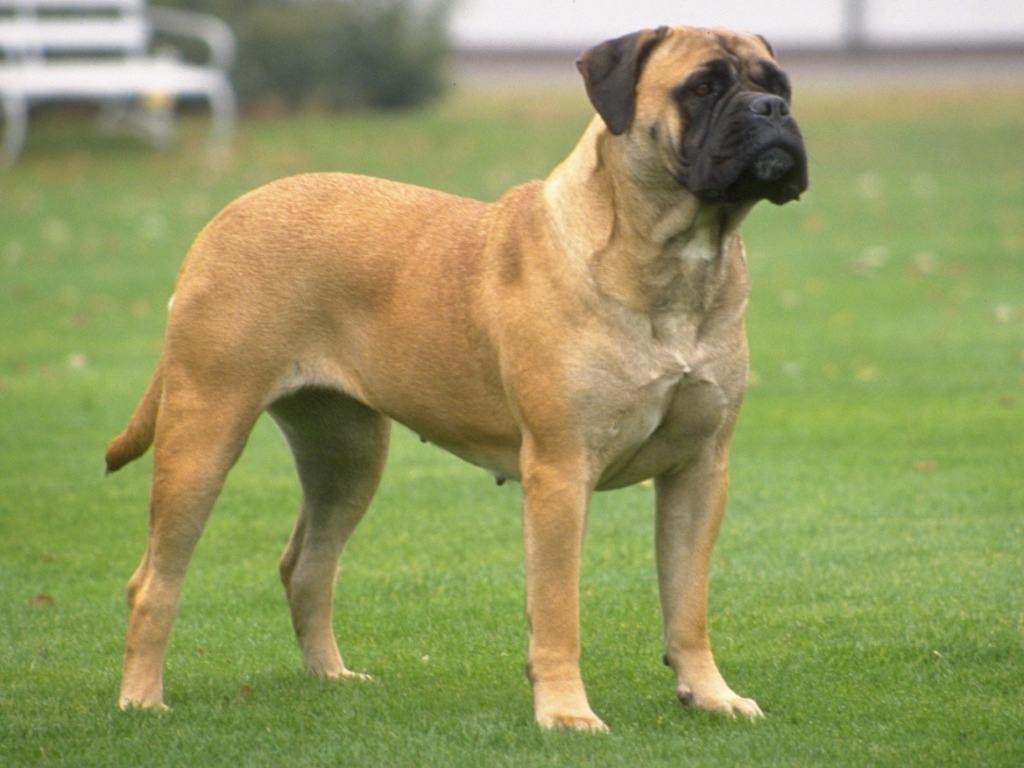
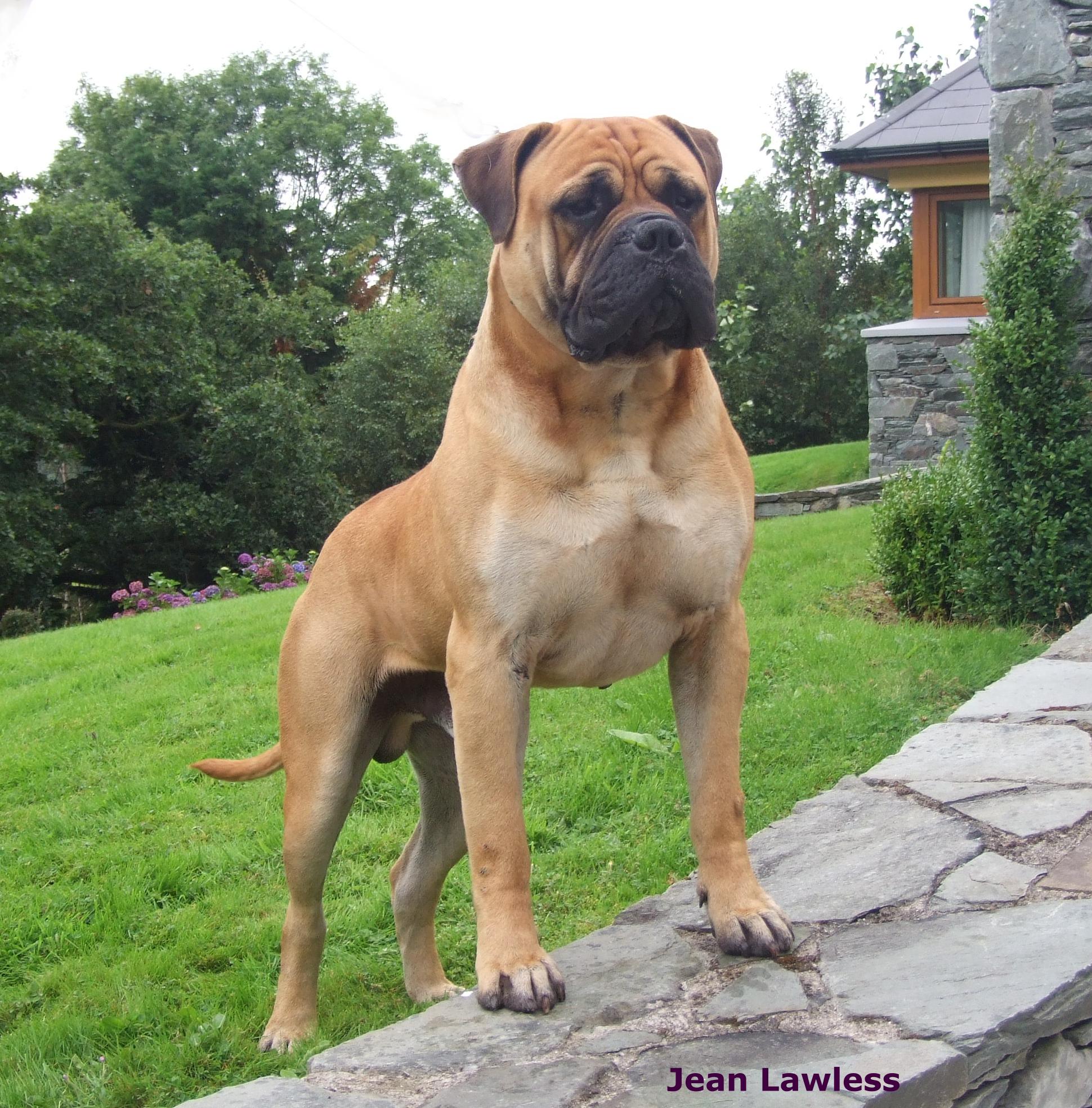
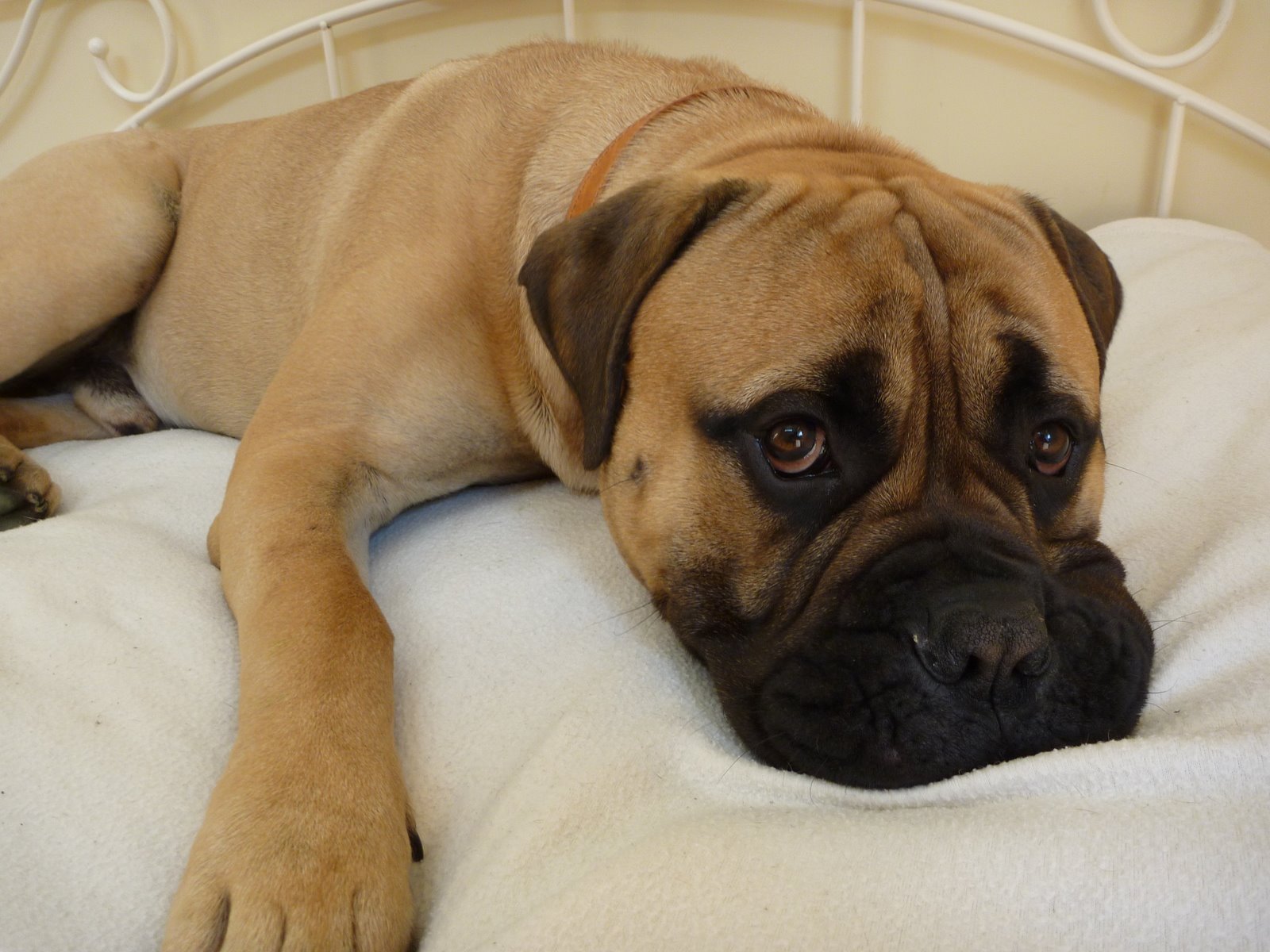
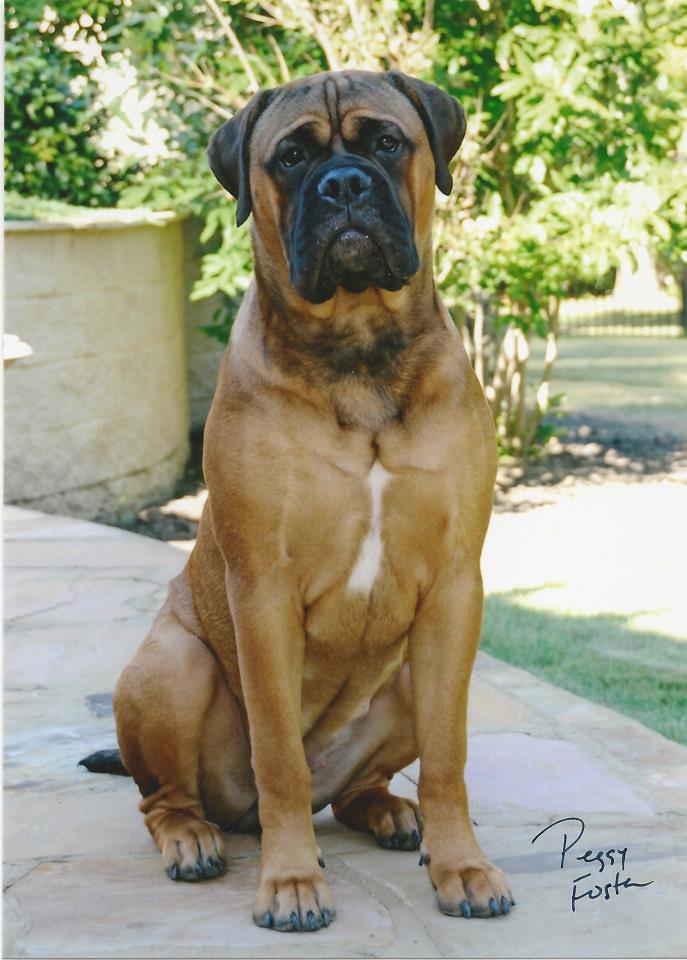

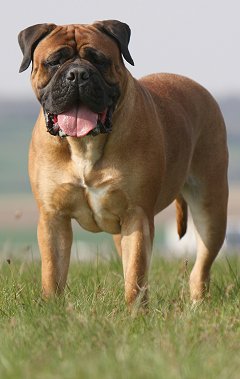
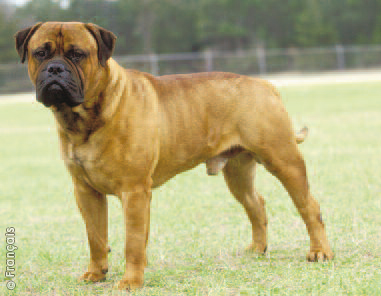
 Animalia Life
Animalia Life